Abstract
Prolonging one’s ability to drive is a significant component of aging in place and personal autonomy. However, highly prevalent neurodegenerative conditions such as Alzheimer’s disease and related dementia among older people undermine the safety associated with driving and inevitably lead to their premature cessation of driving. This scoping review, based on PRISMA guidelines, extracted data from 40 research studies to highlight the on-road risks associated with driving with dementia or cognitive impairment. We identified 22 distinct risks, with speed compliance, navigation, lane adherence, turning, and stopping as the most reported risks in the identified studies. The study linked these risks to key cognitive domains and mapped out the scope of emerging driving technologies (semi-autonomous, autonomous, and aftermarket products) to address or mitigate the risks. The findings underscore the need to apply or create a framework for the design and development of inclusive driving interfaces to accommodate aging-related cognitive deficits.
1. Overview
The crossover between aging-associated dementia and driving is important considering the projected prevalence of dementia and the desire of the aging population to sustain their driving. In the United States (U.S.), the lack of reliable public transportation makes driving a crucial component of everyday life and a significant source of independence. In addition to limited access, the existing public transportation systems are often outdated, underfunded, and multifaceted [1]. While older adults in general have a desire to use ride sharing, ride sharing networks are not geographically ubiquitous and the applications are often found to be challenging to navigate [2]. As a result, individuals with dementia are left with no choice but to drive themselves or rely on a caregiver as a means of transportation.
Despite the high prevalence of dementia and the well-known risks associated with driving with neurocognitive deficits, there are currently no nationwide regulations in the United States or standardized methods to evaluate and restrict individuals with dementia from driving. Consequently, individuals with dementia and their informal caregivers are expected to self-monitor driving-associated risks and make their own decisions about whether to continue driving. The purpose of this scoping review is to identify and compile the on-road risks associated with driving with dementia, as well as to elucidate the scope of driving-based technology to potentially mitigate such risks.
2. Background
The growing population of those over 65 years old in the U.S. has led to a corresponding surge in the prevalence of age-related conditions like dementia. According to the Centers for Disease Control (CDC), one in nine people within the U.S. aged 65 and older have a diagnosis of dementia [3]. Dementia is an overarching term that encompasses many different subtypes, including Alzheimer’s disease (AD), which can present with a cluster of symptoms such as loss of memory, language, problem-solving, and other executive function deficits [4]. The presence of these symptoms may interfere with the individual’s daily routines and lead to the loss of certain skills and abilities as the disease progresses [4]. Driving is one area that can be largely impacted when symptoms of cognitive decline associated with the onset of dementia begin to emerge. Changes in memory, attention, processing speed, visual and spatial abilities, judgment, and reasoning may pose challenges in critical aspects of driving [5,6].
These cognitive changes when combined with driving raise concerns, as driving is a multi-level task that places a high demand on many cognitive, perceptual, and motor functions [7]. The driving environment is dynamic and unpredictable, and therefore the ability to execute real-time decisions is a large factor in sustained safe driving. The task demands the need for attention, quick reaction times, and a high level of cognition to adjust and adapt effectively to make decisions to meet the needs of the changing environment.
When these critical skills are impacted by cognitive impairment, the likelihood of unsafe actions and poor decision-making increases, raising concerns about the safety of the driver and those around them. The amount of risk associated with driving and dementia has been connected to the stage or severity of the disease [8]. An individual in the mild stages may not yet be showing any signs of concern when driving. However, studies have observed the frequency of vehicle crashes increases on or after year three of dementia onset [8]. After three years of onset, individuals with dementia are known to experience a more significant decline in cognitive domains such as attentional capacity, processing speed, executive functions, and visuospatial skills [6].
Previous studies that have analyzed the frequency and odds of road accidents among drivers with dementia offer interesting perspectives. One of the preliminary studies found that drivers with dementia had an overall mean annual crash rate of 0.091, compared with 0.040 for age-matched controls [9]. This represented a slightly increased risk in crash rates for this population, with incremental increases with years from onset of disease. In the early stages of dementia, there were notably lower crash rates; in year one, the crash rate was 0.068, in year three, 0.093, and in year five, 0.129 [7]. Furthermore, when aging and time since onset of dementia were factored in, drivers between the ages of 70 and 79 were 2.9 times more likely, and drivers aged 80 years and older were 7.5 times more likely, to misjudge or fail to detect a vehicle approaching the intersection, resulting in a crash [10]. In contrast, a retrospective cohort study examining crash risk for licensed individuals aged 65–79 years showed that individuals with dementia had lower rates of car crashes compared to those without dementia [11]. A plausible reason for this finding was that individuals with dementia reported lower driving mileage as a result of changes in their driving habits, often enforced by family members and caregivers. Such limited driving exposure may not accurately reflect the risky driving behaviors present in this population, potentially underemphasizing the importance and need for an intervention and evaluation of the associated risks.
Safety should be a main priority when determining whether an individual should continue to drive or have their license revoked. There are multiple warning signs that may indicate that an individual is not fit to drive and should be referred for further evaluation. For instance, if a caregiver observes that an individual no longer remembers how to travel to familiar places, has trouble adhering to traffic signs and signals, becomes angry or confused, frequently taps the brakes, or returns home with minor car damage, they should inform a primary care provider and seek further evaluation [12]. Within current research, both simulated and on-road assessments are being analyzed to predict one’s fitness to drive [7,13], with some researchers stressing that on-road driving tests should be the preferred approach, as they offer practical and real-world driving experiences [6]. However, the integration of such assessments to regulate continued driving with dementia or cognitive deficits is not being effectively enforced.
Within the U.S., there is variability surrounding the laws about driving cessation and the need to report a diagnosis to the state registry department. At this time, only ten out of the fifty states have laws around reporting changes in one’s fitness to drive [14]. Of those ten states, only two, Connecticut and Massachusetts, require individuals diagnosed with dementia to have frequent reevaluations of their driving abilities [14]. The variability surrounding laws on driving cessation of individuals with dementia can make it challenging for everyone involved in the process to determine someone’s fitness to drive. In the interim, the implementation of driving technology could mitigate these safety risks and prolong cessation.
3. Driving Technology for Individuals with Dementia
Current advancements in technology show promising potential; however, there is a lack of research exploring the implementation of these technologies for older adults with dementia. One possible solution that has yet to be explored extensively through observational studies is driving-based technology. For the purpose of this study, driving-based technology includes vehicle automation, GPS location-based systems, in-vehicle monitoring systems, and systems that monitor the vehicle’s environment. As of early 2025, vehicles that are available for purchase in the U.S. can include automation to support the driver in steering and braking/acceleration; however, the driver is still responsible for operating the vehicle at all times [15]. In California and Nevada, consumers can also purchase vehicles where automation will completely take over the driving task for short periods of time [16]. These different levels of automation, and especially full vehicle autonomy, might provide the appropriate level of assistance to match the severity of an individual’s dementia progression [17].
4. Problem Statement
With the U.S. population being as old as it has ever been, there are increasing numbers of individuals living with dementia who continue to drive despite cognitive changes. The pressing issue remains that, although large volumes of research are being conducted to assess the risks of driving for this population, there have yet to be guidelines established and interventions implemented to promote safety. The lack of a standardized method to assess the fitness to drive in individuals with dementia presents a significant safety concern for everyone on the road. One research area that needs to be further explored is the implementation of driving-based technology for this population. This technology could be used to address and monitor the risks associated with driving in this population. As a result, this technology may prolong the cessation of driving, promoting autonomy, reducing loneliness, and alleviating caregiver burden. This paper presents a scoping review that highlights the need for further investigation to comprehensively identify the real-world risks associated with driving with dementia and to evaluate the scope of technology in relation to those risks.
5. Methods
Our team conducted a scoping review to comprehensively identify the real-world, on-road risks associated with dementia and driving. The review protocol followed the Preferred Reporting Items for Systematic Reviews and Meta-Analysis (PRISMA) guidelines. This scoping review has been registered in the Center for Open Science, and the study materials including the search strategy, search results, and data extraction sheet can be accessed via the following link: https://osf.io/zuadn/.
For inclusion in this scoping review, articles needed to specifically address individuals with cognitive impairment, dementia, AD, or preclinical markers of AD, in addition to the inclusion and exclusion criteria shown in Table 1. Articles prior to the year 2000 were excluded, as aging-related demographic trends with driving and transportation may have changed since then. Due to practical barriers with access to content, articles not written in English, those not published in peer-reviewed journal, or those without full-text access were also excluded. One specific exclusion criterion included in Table 1 pertained to individuals with comorbidities, to ensure that findings were directly related to cognitive impairments and not influenced by confounding variables or other conditions. Quantitative, qualitative, mixed-methods, as well as simulated and on-road assessments were included to consider different aspects of the topic.

Table 1.
Overview of inclusion and exclusion criteria and search criteria.
A generic search was performed in the EBSCOhost database. The optimal search strategy was refined via title screening based on the research question, as well as by selecting seven articles to be placed into the Medical Subject Headings (MESH) to generate more specific search terms, as shown in Table 2. The appropriate descriptors derived from the MESH were used to refine the final list of Boolean operators, as shown in Table 3. Searches were carried out from September to October 2024. A total of 979 search results from EBSCOhost were imported into Covidence software (https://app.covidence.org/reviews/490239 (accessed on 4 March 2025)) and duplicate articles were removed, resulting in a total of 306 articles. Titles and abstracts were independently screened by three researchers, and articles that did not meet the inclusion criteria were excluded, resulting in 164 articles for the full-text review. The main reasons for exclusion were titles and abstracts that were not in English, did not relate to driving, or did not involve participants with cognitive deficits.

Table 2.
MESH search articles.

Table 3.
EBSCOhost Boolean search operator string.
Before completing the full-text review, three researchers spent one hour independently reviewing 10 articles chosen at random, cross-checking them for accuracy on whether the article was included or excluded based on the predetermined criteria. Researchers did not proceed with the full-text review until a benchmark of 80% agreement on inclusion–exclusion rate was reached. A 90% agreement was met following the first cross-check, which demonstrated consistency among the researchers. A total of 164 articles then went through a full-text review for inclusion in data extraction. This was completed independently by two members of our team, with disagreements discussed and resolved with an additional team member. During the full-text review, articles were further excluded under the following circumstances: the study focused only on participants without cognitive deficits; the participants had comorbidities; the results did not specifically report on individuals with cognitive deficits; no on-road risks were identified; or no full-text version of the articles were found. After exclusion, 68 articles proceeded to the data extraction phase. The extracted data included study region, date of publication, study focus, setting, method, design, diagnosis, number of participants, gender, participant perspective, key findings, and on-road risks. The researchers independently completed data extraction on the same ten articles selected at random and then cross-checked to ensure consistency among the extracted data. The three researchers then met to discuss, identify, and resolve any differences among the data extracted from those ten articles. Key differences among the three researchers were related to the proper identification of the study design and method and the extraction of findings related to driving. Out of the 68 original articles from the initial data extraction phase, 28 were removed after further analysis due to expert opinions, duplicates, or not identifying any specific on-road risks. This resulted in a final number of 40 articles for the full-text final data extraction. The final PRISMA flowchart can be seen in Figure 1.
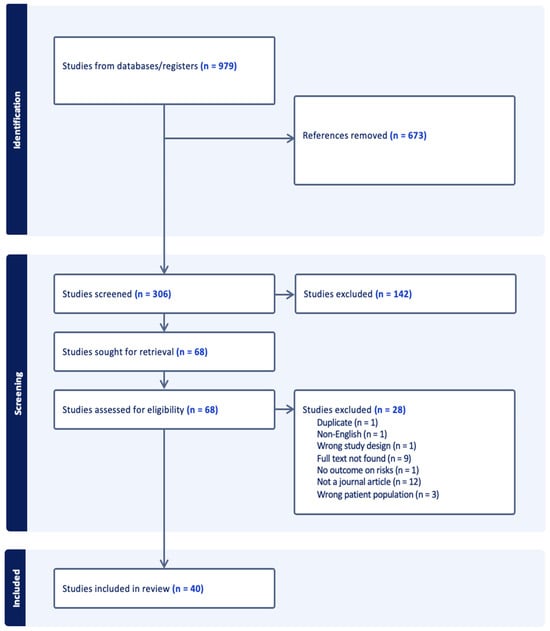
Figure 1.
Flow diagram for studies included in scoping review.
6. Findings
6.1. The Corpus
As shown in Figure 2, of the 40 articles selected for data extraction, most studies focused on naturalistic driving (42%), while some focused on simulated driving, and another major portion (38%) utilized a variety of methods such as self-reporting, secondary analysis, and reviews. More than 50% of the studies were quantitative (See Figure 3), and about 40% utilized observational methods (See Figure 4). As indicated in Figure 5, a major portion (77%) of the studies focused on the direct perspective of the driver with AD. In terms of evolving focus, we noticed a rising trend in studies focused on driving with dementia since the year 2005 (Figure 6). All the studies included in this review were conducted in middle- or high-income countries. Of the 40 articles, 31 were conducted in North America, 3 in Oceania, 2 in East Asia, 2 in South America, and 2 in Europe. The total number of participants with cognitive impairment within the 40 studies was 2026. Generally, from the data gathered, 1259 (57%) participants were male, and 932 (43%) were female; however, these data are not complete, as several studies did not report on gender or did not differentiate between drivers with AD, healthy controls, or caregivers/stakeholders. Therefore, this number may include some individuals with no cognitive impairment. As shown in Figure 6, over a 24-year period, there has been growth in this area of research, demonstrating an expansion of knowledge and potentially due to advancements in technology.

Figure 2.
Study setting breakdown.
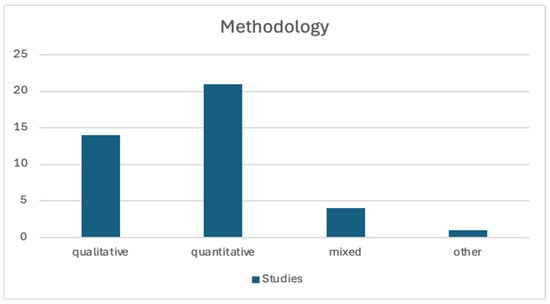
Figure 3.
Study methods.
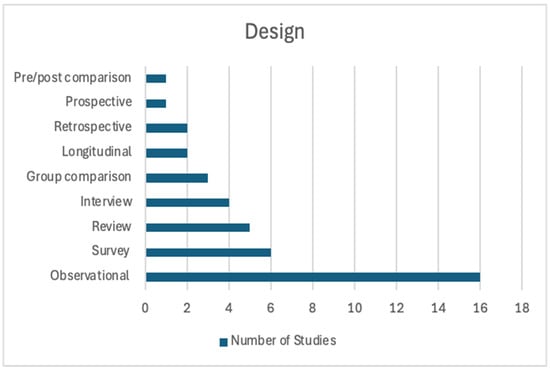
Figure 4.
Study design.
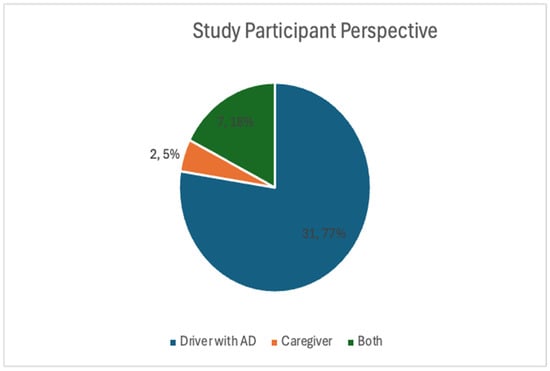
Figure 5.
Distribution of study participant perspectives.
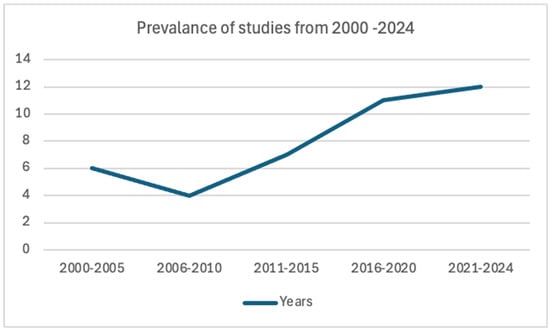
Figure 6.
Trendline based on publication year.
6.2. Risk Factors When Driving with Dementia
Table 4 shows, in descending order, the breakdown of the identified on-road risk factors as categorized by the researchers to consolidate and best represent such risks. This list was generated by tallying the recurring risks found among the 40 articles during data extraction. Out of the 22 risks reported, the top 5 were speed compliance (found in n = 24 of the 40 articles), getting lost/unfamiliar routes (n = 17), turning and the use of turn signals (n = 17), lane adherence and maintenance (n = 15), and the failure to stop (n = 13). The top five cognitive skills related to the risks included attentional capacity, visual–spatial skills, processing speed, memory, and executive functioning. The findings were consistent across the 40 articles, highlighting many of the same risks and cognitive skills associated.

Table 4.
Identified on-road risks and connection to cognitive skills and application category of technological solutions.
7. Discussion
This scoping review included 40 studies that examined the driving performance of individuals with dementia and cognitive impairment. These studies consisted of driving records, experimental driving studies (both simulated and naturalistic), driving rehabilitation programs, safety questionnaires, interviews, and systematic reviews. The findings identified a total of 22 common on-road risks, with the 5 most common risks being speed compliance, getting lost/unfamiliar routes, turning and the use of turn signals, lane adherence and maintenance, and the failure to stop. These risks may be compounded when certain tasks identified as requiring fast decision-making, such as changing routes, switching lanes, overtaking, checking blind spots, monitoring speed, and braking, are involved [18].
Most of the risks were identified in naturalistic driving studies, which was expected as on-road driving assessments are the gold standard to determine one’s fitness to drive [19,20]. One review investigated the cognitive domains associated with poor driving performance or the unfitness to drive by examining studies that measured the outcomes in patients with cognitive impairment or AD using a simulator or on-road driving [6]. The cognitive domains identified by that review, which are frequently reported with unsafe driving and driving cessation for older adults with cognitive impairment or AD, were consistent with the cognitive skills identified in our scoping review [5,6,7]. Our team summarized that the cognitive skill deficits mainly contributing to such risks relate to attentional capacity, processing speed, visual–spatial, executive functioning, and memory.
It is well established in the literature that drivers with dementia experience cognitive changes that impact their fitness to drive, leading to unsafe driving or driving cessation [18]. This scoping review identified specific on-road risks that may contribute to this unsafe driving thus leading to cessation. Our next step was to relate these specific risks identified in the literature with the use case categories identified by Detjen and colleagues [21]. Describing our findings in terms of the use case categories allowed us to see our results from the perspective of overarching themes for accessible mobility. We also related the specific risks to the level of automation that could address the risk. Finally, we also identified current technology that could support drivers with dementia to better manage the identified risks. This final step was included to expand the scope of driving-based technology in mitigating these risks, potentially delaying the cessation of driving for this population.
One specific driving-based technology to consider is semi-autonomous and fully automated vehicles. The Society of Autonomous Engineers (SAE) defines six levels of driving automation as follows [22]. In Figure 7, we have depicted each level in concentric circles and mapped the identified driving risks in our review (using arrows within the circle) to be potentially mitigated through increasing levels of driving automation. Level 0 (no driving automation) does not include any autonomous technology, requiring the driver to be fully engaged in operating the vehicle at all times. However, some Level 0 vehicles provide warnings or alerts to notify drivers of potential risks. Level 1 (driver assistance) provides continuous assistance with lateral or longitudinal control (steering or braking/accelerating), allowing for adaptive cruise control or lane-keeping assistance. Level 2 (partial driving automation) provides assistance with both lateral and longitudinal control. Level 3 (conditional driving automation) vehicles can perform lateral and longitudinal driving tasks in specific situations, and the system now also handles environmental monitoring; however, the driver must be available to take control if the system requests assistance or stops functioning effectively. Level 4 (high driving automation) vehicles are completely responsible for all driving and navigation tasks within certain driving conditions or parameters. Level 5 (full driving automation) autonomous vehicles take full control of all driving tasks, not requiring human input beyond high-level navigational input (e.g., choosing a pick-up location).
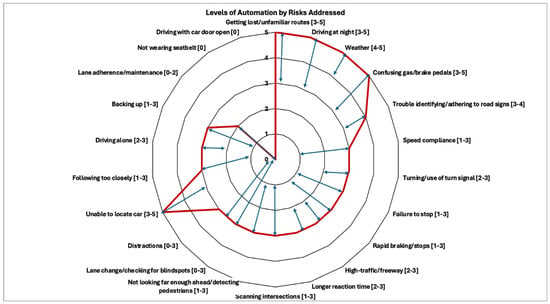
Figure 7.
Levels of automation organized by risks addressed.
It can be expected that Level 4 (when operated within their operational design domain) or Level 5 vehicles would mitigate most on-road risks tied to human error in navigational or monitoring tasks. However, this is only the case for contexts that are exclusively populated by vehicles of these levels of automation; mixed traffic (i.e., any context in which vehicles with systems of different automation levels interact with each other), especially when highly automated vehicles interact with vehicles of Levels 3 and below, bears its own set of risks beyond the “regular” manual driving risks [23]. The SAE level definitions “can be used to describe the full range of driving automation features equipped on [motor] vehicles in a functionally consistent and coherent manner”. The range of challenges arising from dementia go beyond handling or not handling driving or monitoring tasks and can also include issues such as not remembering whether an automation system is switched on or off (mode confusion), not understanding or not being able to complete a request to resume manual control, and navigational challenges (e.g., being unable to confirm the destination post arrival or forgetting the purpose of a trip halfway through), among others.
In order to provide a solution space for mobility technology that can address issues beyond maneuvering, navigation, and monitoring for able-bodied people, Detjen et al. proposed a design framework for accessible and inclusive future mobility [21]. The design space also includes a categorization of inclusive mobility use cases into the seven categories of safety, convenience, ride configuration, communication, orientation, productivity and entertainment, and connection aids. Table 4 provides a comprehensive list of the on-road risks, cognitive skills, and the matching inclusive mobility application category. The researchers also identified additional after-market technology to address some of the on-road risks, which can be seen in Table 4. However, it is important to note that these would still require human input to operate the vehicle and may only partially address the risk.
A form of technology that could potentially monitor and report risky driving behaviors as opposed to taking over driving completely is GPS in-vehicle monitoring systems. These technologies are commonly used to report employees’ locations and driving speeds to large commercial companies, but they have yet to be applied to the population of interest in this review. In a study with drivers with AD, in-vehicle monitoring was able to detect driving without a seat belt, delayed response time, driving too fast for environmental conditions, traffic violations, poor judgment, and not scanning intersections as the most frequently occurring safety errors. GPS tracking has the ability to report the driver’s location, as well as instances of speeding, sudden braking, or acceleration [24]. This demonstrates the potential for technology to provide valuable information to ensure the safety of this population while driving, providing caregivers with a sense of security and relief, as they can monitor their loved ones.
7.1. Implications
The study findings have implications for those involved with determining safety for drivers with dementia. Family and caregivers can be more aware of the risks to look out for and be more informed about the technological advances that can be used to improve driving performance and safety. Driving rehabilitation specialists can use this knowledge to further explore the use of autonomous vehicles and other technology when determining fitness to drive. Currently, there are limited after-market technologies available for purchase to address the on-road risks associated with this population, therefore car manufacturers and engineers may consider developing new technology to fill this gap and modify their existing car. Additionally, when developing this technology, engineers should consider the characteristics of individuals with cognitive impairments [17]. This may enhance the perceived usefulness and acceptance of such technology for drivers with dementia. As a co-design approach, they should involve the perspectives of older drivers with dementia and their caregivers to ensure the driving technology interface negates or minimizes any information processing burden.
7.2. Strengths and Limitations
In an attempt to increase the rigor of our scoping review, the researchers met frequently to discuss the process and performed multiple cross-checks to ensure consistency. The present review has some limitations, despite following the PRISMA guidelines. One limitation pertains to the variability in reporting on the type of diagnosis, as some studies used the diagnoses of cognitive impairment, dementia, and AD interchangeably. The researchers included studies with pre-clinical markers for AD, where the subjects had not yet been diagnosed with cognitive impairment but were likely to develop one in the future. We also found prevailing ambiguities around language regarding the levels of driving automation. Lastly, articles not written in English, not peer-reviewed, and those without a full-text version were excluded, which may have limited the breadth of our findings.
8. Conclusions
This scoping review provides valuable insights into the specific on-road risks faced by drivers with dementia and cognitive impairment. These risks were consistently reported across studies, displaying the need for interventions related to driving-based technology. By mapping these risks to the appropriate vehicle-based technologies, this study highlights the potential for those technologies to enhance safety, delay driving cessation, and promote continued independence for this population. Concerning automated driving technology, while Levels 4 and 5 would address most of these risks, it must be understood that the current state of technology is still at Level 2. That being said, Levels 1–3 have the potential to significantly mitigate many of the risks associated with dementia and driving, and the possibility of incorporating these levels into driving rehabilitation programs should be explored further.
This research adds to the body of knowledge surrounding this topic, as it connects on-road driving risks with cognitive skills and begins to explore specific features of driving-based technology that can be used to intervene and address these risks. Future research should consider conducting simulated driving scenarios with different technologies, including the different levels of AV, to inform drivers on how to utilize technology while demonstrating its value and usefulness. This may ease drivers’ concerns about using technology by instilling confidence and increasing acceptance. The use of technology to address safety, delay cessation, and promote independence may contribute to the well-being of drivers with dementia and help to alleviate caregiver burden.
Funding
This research received no external funding.
Institutional Review Board Statement
Not applicable.
Informed Consent Statement
Not applicable.
Data Availability Statement
Data from this scoping review can be accessed from the Open Science Framework through this link: https://osf.io/zuadn/.
Conflicts of Interest
Author Alexander G. Mirnig was employed by the company Austrian Institute of Technology. The remaining authors declare that the research was conducted in the absence of any commercial or financial relationships that could be construed as a potential conflict of interest.
References
- National Aging and Disability Transportation Center. Accessible Transportation for People Living with Dementia. Available online: https://www.nadtc.org/news/blog/accessible-transportation-for-people-living-with-dementia/ (accessed on 29 September 2024).
- Bayne, A.; Siegfried, A.; Beck, L.F.; Freund, K. Barriers and facilitators of older adults’ use of ride share services. J. Transp. Health 2021, 21, 101055. [Google Scholar] [CrossRef] [PubMed]
- Kramarow, E.A. National Health Statistics Reports. Center for Disease Control. Available online: https://www.cdc.gov/nchs/data/nhsr/nhsr203.pdf (accessed on 29 September 2024).
- Alzheimer’s Association. What Is Dementia? Alzheimer’s Disease and Dementia. 2024. Available online: https://www.alz.org/alzheimers-dementia/what-is-dementia (accessed on 16 October 2024).
- Fuermaier, A.B.M.; Piersma, D.; de Waard, D.; Davidse, R.J.; de Groot, J.; Doumen, M.J.A.; Bredewoud, R.A.; Claesen, R.; Lemstra, A.W.; Scheltens, P.; et al. Driving difficulties among patients with alzheimer’s disease and other neurodegenerative disorders. J. Alzheimer’s Dis. 2019, 69, 1019–1030. [Google Scholar] [CrossRef] [PubMed]
- Quintas, J.L.; Trindade, I.O.; Gameiro, K.S.; Pitta, L.S.; Camargos, E.F.; Nóbrega, O.T. Neuropsychological domains and fitness to drive in mild cognitive impairment or Alzheimer’s disease. Accid. Anal. Prev. 2023, 191, 107188. [Google Scholar] [CrossRef] [PubMed]
- Hird, M.A.; Egeto, P.; Fischer, C.E.; Naglie, G.; Schweizer, T.A. A systematic review and meta-analysis of on-road simulator and cognitive driving assessment in Alzheimer’s disease and mild cognitive impairment. J. Alzheimer’s Dis. 2016, 53, 713–729. [Google Scholar] [CrossRef] [PubMed]
- Brown, L.B.; Ott, B.R. Driving and dementia: A review of the literature. J. Geriatr. Psychiatry Neurol. 2004, 17, 232–240. [Google Scholar] [CrossRef] [PubMed]
- Drachman, D.A.; Swearer, J.M. Driving and Alzheimer’s disease: The risk of crashes. Neurology 1993, 43, 2448–2456. [Google Scholar] [CrossRef] [PubMed]
- Braitman, K.A.; Kirley, B.B.; Ferguson, S.; Chaudhary, N.K. Factors leading to older drivers’ intersection crashes. Traffic Inj. Prev. 2007, 8, 267–274. [Google Scholar] [CrossRef] [PubMed]
- Fraade-Blanar, L.A.; Hansen, R.N.; Chan, K.C.; Sears, J.M.; Thompson, H.J.; Crane, P.K.; Ebel, B.E. Diagnosed dementia and the risk of motor vehicle crash among older drivers. Accid. Anal. Prev. 2018, 113, 47–53. [Google Scholar] [CrossRef] [PubMed]
- Almeida, W.M.; Quintas, J.L.; Trindade, I.O.A.; Pitta, L.S.R.; Louzada, L.L.; Nóbrega, O.T.; Camargos, E.F. Diagnosis of Alzheimer’s dementia and vehicle driving restriction: A scoping review. Psychogeriatrics 2024, 24, 138–144. [Google Scholar] [CrossRef] [PubMed]
- Devlin, A.; McGillivray, J.; Charlton, J.; Lowndes, G.; Etienne, V. Investigating driving behaviour of older drivers with mild cognitive impairment using a portable driving simulator. Accid. Anal. Prev. 2012, 49, 300–307. [Google Scholar] [CrossRef] [PubMed]
- Dementia Care Central. Driving & Dementia/Alzheimer’s: State Laws, Coping & Advice for Caregivers. Available online: https://www.dementiacarecentral.com/caregiverinfo/driving-problems (accessed on 10 October 2024).
- United States Environmental Protection Agency. Self-Driving Vehicles. Available online: https://www.epa.gov/greenvehicles/self-driving-vehicles (accessed on 10 October 2024).
- Scoblete, G. The Emerging Risks of Level 3 Autonomous Vehicles. Verisk. Available online: https://core.verisk.com/Insights/Emerging-Issues/Articles/2024/September/Week-4/The-Emerging-Risks-of-Level-3-Autonomous-Vehicles (accessed on 31 September 2024).
- Haghzare, S.; Stasiulis, E.; Delfi, G.; Mohamud, H.; Rapoport, M.J.; Naglie, G.; Mihailidis, A.; Campos, J.L. Automated vehicles for people with dementia: A “tremendous potential” that “has ways to go”—Reports of a qualitative study. Gerontol. 2022, 63, 140–154. [Google Scholar] [CrossRef] [PubMed]
- Davis, R.; Owens, M. Self-regulation of driving behaviors in persons with early-stage Alzheimer’s disease. J. Gerontol. Nurs. 2021, 47, 21–27. [Google Scholar] [CrossRef] [PubMed]
- Duchek, J.M.; Carr, D.B.; Hunt, L.; Roe, C.M.; Xiong, C.; Shah, K.; Morris, J.C. Longitudinal driving performance in early-stage dementia of the Alzheimer type. J. Am. Geriatr. Soc. 2003, 51, 1342–1347. [Google Scholar] [CrossRef] [PubMed]
- Hemmy, L.; Rottunda, S.; Adler, G. The Older Driver with Cognitive Impairment: Perceptions of Driving Ability and Results of a Behind the Wheel Test. Geriatrics 2016, 1, 6. [Google Scholar] [CrossRef] [PubMed]
- Detjen, H.; Schneegass, S.; Geisler, S.; Kun, A.; Sundar, V. An emergent design framework for accessible and inclusive future mobility. In Proceedings of the 14th International Conference on Automotive User Interfaces and Interactive Vehicular Applications, Seoul, Republic of Korea, 17–20 September 2022; pp. 1–12. [Google Scholar] [CrossRef]
- Society of Automobile Engineers. Taxonomy and Definitions for Terms Related to Driving Automation Systems for On-Road Vehicles. 2021. Available online: https://www.sae.org/standards/content/j3016_202104/ (accessed on 2 December 2024).
- Miller, L.; Koniakowsky, I.M.; Kraus, J.; Baumann, M. The impact of expectations about automated and manual vehicles on drivers’ behavior: Insights from a mixed traffic driving simulator study. In Proceedings of the 14th International Conference on Automotive User Interfaces and Interactive Vehicular Applications, Seoul, Republic of Korea, 17–20 September 2022; pp. 150–161. [Google Scholar] [CrossRef]
- Davis, J.D.; Babulal, G.M.; Papandonatos, G.D.; Burke, E.M.; Rosnick, C.B.; Ott, B.R.; Roe, C.M. Evaluation of naturalistic driving behavior using in-vehicle monitoring technology in preclinical and early Alzheimer’s disease. Front. Psychol. 2020, 11, 596257. [Google Scholar] [CrossRef] [PubMed]
Disclaimer/Publisher’s Note: The statements, opinions and data contained in all publications are solely those of the individual author(s) and contributor(s) and not of MDPI and/or the editor(s). MDPI and/or the editor(s) disclaim responsibility for any injury to people or property resulting from any ideas, methods, instructions or products referred to in the content. |
© 2025 by the authors. Licensee MDPI, Basel, Switzerland. This article is an open access article distributed under the terms and conditions of the Creative Commons Attribution (CC BY) license (https://creativecommons.org/licenses/by/4.0/).